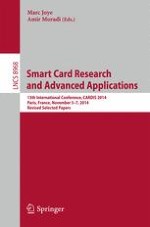2015 | Buch
Smart Card Research and Advanced Applications
13th International Conference, CARDIS 2014, Paris, France, November 5-7, 2014. Revised Selected Papers
herausgegeben von: Marc Joye, Amir Moradi
Verlag: Springer International Publishing
Buchreihe : Lecture Notes in Computer Science
